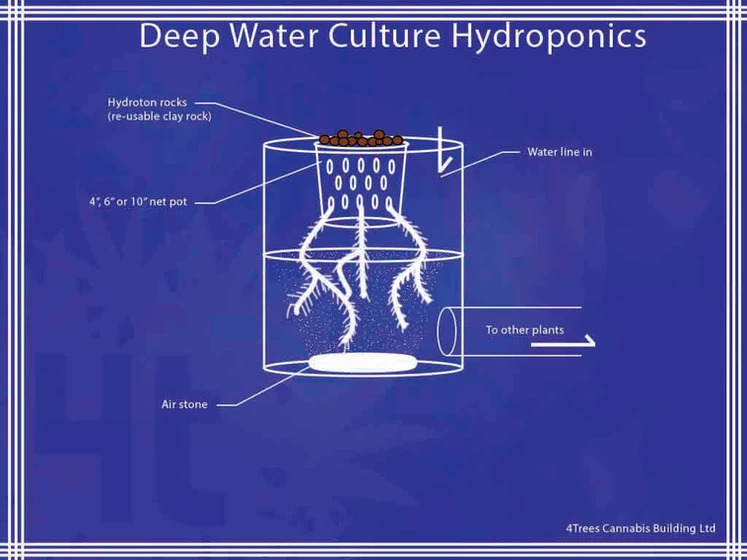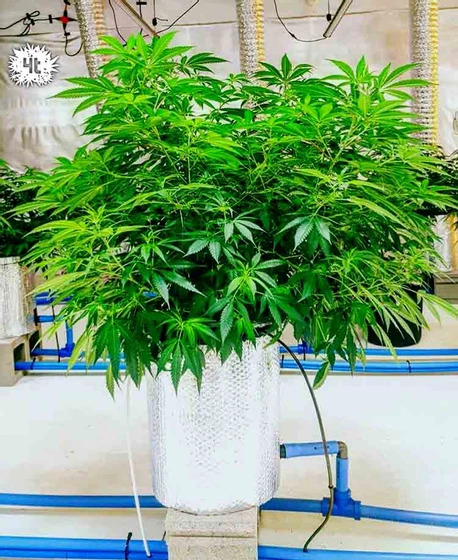Deep water culture is a low maintenance, fast growing method of hydroponics. In this type of system plants sit in net pots with roots suspended in the grow chambers nutrient solution while aerated water recirculates throughout the growing system.
If you have ever heard the term “look at your roots, not your fruits” then you may understand why growing in this style of hydroponics can be very lucrative. When your plant roots have little to no resistance to push against for speedy growth, proper temperatures, oxygen and nutrients its easy to see the incredibly fast, lush growth above the root base that DWC is famous for.
The reason it is called “deep” is because of the small air bubbles that travel up and through the water from your air stone at the bottom of the tank. As these air bubbles travel upwards, they spin, gathering more oxygen in this process and releasing it into your water, increasing your overall dissolved oxygen levels, making deeper water work better for this method.
Higher water volumes in your overall system will also result in less pH, temperature and PPM fluctuations, making the deep aspect of this growing system and the combined grow chambers useful to your lack of size needed for your fertigation room feed tank. Utilizing the grow chambers water volume allows you to have a small controller tank and a compact fertigation room depending on the number of plants you have.

Deep water culture hydroponic systems have immediate access to all the nutrients they need at any given moment, making them easy to over feed if its not done right.
Maintaining a fairly low parts per million of nutrient strength and only raising at peak flowering periods coupled with regular flushing is ideal with deep water culture , this will keep your plants from getting too much nutrients and growing their best.
If your leaves get what’s called “tip burn” where the tips of the leaves begin to get slightly yellow, or burnt and crisp in later stages then you have added too many nutrients. Prior to this happening the plants will likely be a very deep green in color, ideally you want the plants to be vibrant green, not too pale, and not too dark green.
This is only the visible measurement of nitrogen, excess in other nutrients may look different, however, when following a nutrient program they all fall in close proximity, making dark green an easy first sign.
Unlike temperature in the growing environment, there is no good average level to keep your nutrient strength at. Instead, it varies based on the strain, type of nutrients added, stage of growth, light intensity and c02 levels. These variables dictate the optimum levels that your nutrients should be at each week throughout growing stages.
Water consumption, nutrients and labor are at an all time low with deep water culture. This is because a drain to waste style system will waste the nutrients that you feed them each day, where a deep water culture system recirculates the water and it is swapped out once weekly. This accounts for over 90% savings in water & nutrients as well as cuts back drastically on labor needed in filling tanks and mixing nutrients regularly.
This growing method is a favorite for hydroponic gardeners in areas prone to power outages. In the case of an outage the growing system does not dry out or overfill. Instead, the recirculation and aeration stops (as well as everything else in the grow room), however, oxygen remains in your solution for roughly 48 hours which is generally within the time an outage will take to be fixed.
Although this growing method is the safest in the event of a power outage, we still recommend exchanging the nutrient solution for a fresh one once power is back on. Cleanliness is very important in recirculating hydroponics methods.

Once weekly 29% hydrogen peroxide should be added to plain, pH adjusted water and ran through the system for 12 – 24 hours. This will clean your tanks, piping and root base while adding oxygen to the roots. This should be applied at a rate of 3ml per gallon.
Plants leaves will perk up during hydrogen peroxide flushes and flowers will swell due to the added oxygen making this tip both useful for a clean system and good growth.
Licensed for a certain number of plants? Out of all the types of hydroponic systems, this is one of the best for utilizing your plant count and making the most of it with its ability for large bush style growth. Filling large areas with very few plants is easy with deep water culture.
As amazing of a growing system as deep water culture is, it is not right for every scenario though. The large bush style growth does mean you will have to keep them in the vegetative state for longer (2 – 4 weeks) and ideally have a larger vegetative room. Water chillers will also be required to maintain a correct water temperature due to the water passing through the warm grow room pipes.
If vegetative space is low, water or nutrient consumption is not of big concern or you want to throw a grow system together faster then an automated stone wool, or coconut husk drain to waste hydroponic system may be more up your ally.
Although DWC can cater to the low plant count grower and produce large bushes it can also be designed closer together and focus on top flowers. Proper grow room design and fertigation planning is crucial to a successful deep water culture system.
There is no growing method quite like a fully automated DWC system. The level of control over your plants roots in a recirculating hydroponics system offers the healthiest, fastest growing plants possible.

